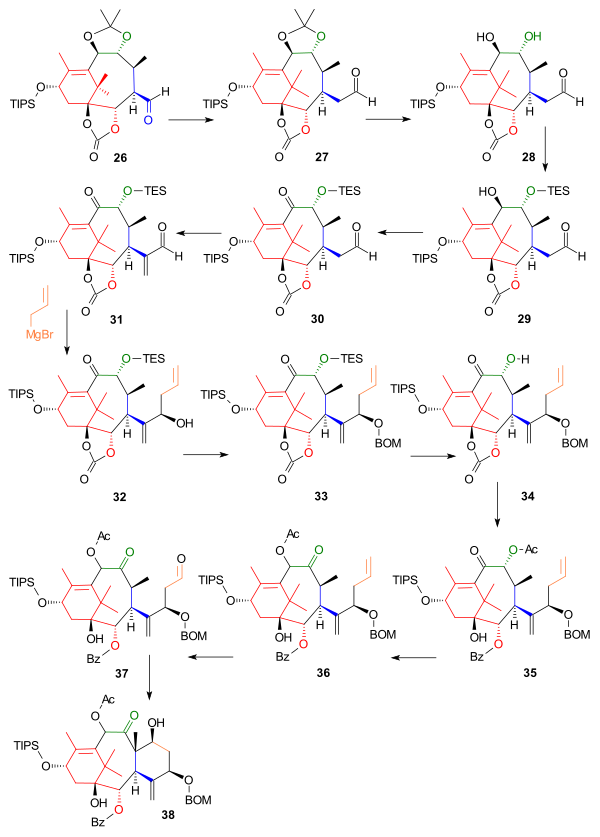Wender Taxol total synthesis Last updated October 26, 2025 AB ring synthesis The taxol synthesis started from the terpene verbenone 1 in Scheme 1 , which is the oxidation product of naturally occurring α-pinene and forming ring A. Construction of ring B started with abstraction of the pendant methyl group proton by potassium tert -butoxide (conjugated anion is formed) followed by nucleophilic displacement of the bromine atom in prenyl bromide 2 to form diene 3 . Ozonolysis of the prenyl group (more electron-rich than the internal double bond) formed aldehyde 4 , which, after isomerization or photorearrangement to the chrysanthenone 5 , was reacted with the lithium salt (via LDA ) of the ethyl ester of propiolic acid 6 in a nucleophilic addition to the alcohol 7 . This compound was not isolated but trapped in situ with trimethylsilyl chloride to the silyl ether 9 . In the next step, Gilman reagent 8 is a methylating reagent in nucleophilic conjugate addition through the alkyne group to the ketone group, which formed the alcohol 10 . The silyl ether protective group was removed by reaction with acetic acid to alcohol 11 , which was then oxidized to the ketone 12 with RuCl2 (PPh3 )3 and NMO as the sacrificial catalyst . The acyloin group in 13 was introduced by KHMDS and Davis’ oxaziridine (see Holton Taxol total synthesis for another use of this system) and its hydroxyl group together with the ester group were reduced by lithium aluminium hydride to tetrol 14 . Finally, the primary alcohol group was protected as a tert -butyldimethylsilyl etherimidazole in triol 15 .
Wender Taxol Scheme 1 Scheme 1
In the second part (Scheme 2 ) the procedures are still confined to rings A and B. More protective groups were added to triol 15 as reaction with PPTS and 2-methoxypropene gives the acetonide 16 . At this point the double bond in ring A was epoxidized with m -CPBAsodium carbonate to epoxide 17 and a Grob fragmentation (also present in the Holton effort) initiated by DABCO opened up the AB ring system in alcohol 18 , which was not isolated but protected as a TIPS silyl ether 19 with triisopropylsilyl triflate and 2,6-lutidine . The C1 position was next oxidized by the phosphite ester , P(OEt)3 and the strong base KOt -Bu , and oxygen to alcohol 20 (the stereochemistry controlled by bowl-shaped AB ring with hydroxylation from unhindered convex direction), the primary alcohol group was deprotected with ammonium chloride in methanol to diol 21 and two reductions first with NaBH4 to triol 22 and then hydrogen gas and Crabtree's catalyst give triol 23 . These positions were protected by trimethylsilyl chloride and pyridine to 24 and then triphosgene to 25 in order to facilitate the oxidation of the primary alcohol group to the aldehyde 26 by PCC .
Wender Taxol Scheme 2 Scheme 2
References ↑ The Pinene Path to Taxanes. 5. Stereocontrolled Synthesis of a Versatile Taxane Precursor Paul A. Wender et al.J. Am. Chem. Soc. ; 1997 ; 119(11) pp 2755 - 2756; (Communication) doi : 10.1021/ja9635387 ↑ The Pinene Path to Taxanes. 6. A Concise Stereocontrolled Synthesis of Taxol Wender, P. A. et al. J. Am. Chem. Soc. ; (Communication); 1997 ; 119(11); 2757-2758. doi : 10.1021/ja963539z This page is based on this
Wikipedia article Text is available under the
CC BY-SA 4.0 license; additional terms may apply.
Images, videos and audio are available under their respective licenses.




